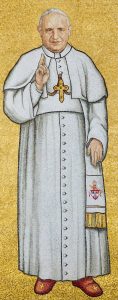
Did you know that the Trinity Dome features a litany of saints who are associated with the United States and the National Shrine? From Mother Teresa to St. John Paul II, these heroes of the faith inspire us to pursue the path of holiness. In this fourth installment of our Saints of the Trinity Dome series, we invite you to learn more about St. Michael the Archangel, St. Gabriel the Archangel, and St. John XXIII.
This post is Part IV in a series – read Post I, Post II, and Post III.
 St. Michael the Archangel
St. Michael the Archangel
Michael the Archangel is a powerful warrior, mentioned most notably in the book of Daniel. He is called a “prince” and a “guardian.” His designation as an archangel shows a level of high authority among the angels in God’s service.
His battle prowess is demonstrated in the book of Jude, which tells us that he argued with the devil over the body of Moses, as well as in Revelation, where he and his forces take on Satan:
“Then war broke out in heaven; Michael and his angels battled against the dragon. The dragon and its angels fought back, but they did not prevail and there was no longer any place for them in heaven. The huge dragon, the ancient serpent, who is called the Devil and Satan, who deceived the whole world, was thrown down to earth, and its angels were thrown down with it.” — Revelation 12:7-9
 St. Gabriel the Archangel
St. Gabriel the Archangel
A special messenger of God, Gabriel appears four times in the Bible. We first see him in the book of Daniel, when he came to Daniel twice to help explain God’s messages of the eschaton and of the exile. He also told Zechariah that he would have a son; Zechariah was serving at the temple when Gabriel appeared to him and reacted in fear and disbelief. Because he questioned God’s word, Gabriel struck him mute, and he remained unable to speak until after John’s birth.
Most significantly, Gabriel is known for being the angel that delivered God’s message to Mary that she would bear His Son. As Luke 1:30-33 says:
“Then the angel said to her, ‘Do not be afraid, Mary, for you have found favor with God. Behold, you will conceive in your womb and bear a son, and you shall name him Jesus. He will be great and will be called Son of the Most High, and the Lord God will give him the throne of David his father, and he will rule over the house of Jacob forever, and of his kingdom there will be no end.’”
 St. John XXIII
St. John XXIII
Known as “The Good Pope,” St. John XXIII was born in 1881 to Italian sharecroppers. He earned his doctorate of theology in 1904, and served as secretary to the bishop of Bergamo and later as a military chaplain.
He then became the archbishop of Areopolis and Apostolic Visitor to Bulgaria, followed by an appointment as the Apostolic Delegate to Turkey and Greece, where he helped locate prisoners of war and made efforts to save refugees during World War II. After the war, he served in Paris as Apostolic Nuncio to assist with the Church’s post-war operations. He expected his post as cardinal-patriarch of Venice to be his last, but in 1958, he was elected pope.
The tone of John XXIII’s papacy was one of peace and unity, but not through diplomatic means. Instead, he emphasized spiritual care, which earned him the moniker “The Good Pope.” His most significant action as pope was to call the Second Vatican Council, known informally as “Vatican II,” with the purpose of guiding the Church to face the unique challenges of the 20th century. Its accomplishments included a reform of the Liturgy, as well as renewed theology of the Church and laity involvement.
Sources:
Rohling, Geraldine M., PhD, MAEd. The Basilica of the National Shrine of the Immaculate Conception: Guide and Tour Book. Washington, D.C.: Basilica of the National Shrine of the Immaculate Conception, 2018.
“Pope John XXII, 1958-1963,” The Vatican.

